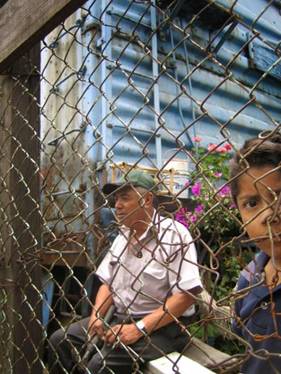|
|
Next President Faces Tough Test Dealing with Mexico's Aging
By Jeremy Schwartz, Mexico City Bureau
Mexico
August
12, 2006

After 34 years of working for the state-owned railroad, Pedro Gonzalez lives in a boxcar with his wife. Six-year-old Eduardo, right, is his neighbor in the boxcar community. Experts say Mexico has time to fix its pension system, but major reform is needed.
Most Mexicans are not covered by pensions, and many of those who are belong to systems on the verge of bankruptcy.
Standing on a crowded corner of a downtown street, Raul Jimenez represents a grim version of Mexico's future.
He has worked as a street vendor most of his life because formal jobs didn't pay enough to survive, and, like tens of millions of others toiling in Mexico's vast underground economy, he has no access to a pension.
Experts say it is a demographic time bomb — an aging population without means for support in their later years — that could explode into a humanitarian crisis if not addressed by whoever prevails in Mexico's disputed presidential election.
"Why should I even think about the future?" said Jimenez, who faces the prospect of selling lighters on the street corner until his body gives out. "My situation is critical, and it will be so until they close my casket."
As election-year politics highlight a raft of economic woes, perhaps the largest problem in Mexico is the most ignored: As many as 80 percent of Mexicans are not covered by pensions, and many of those who are belong to pension systems on the verge of bankruptcy.
Jimenez's bleak case goes a long way in explaining the popularity of leftist presidential candidate Andres Manuel Lopez Obrador, whose most popular move as Mexico City mayor was instituting a $67 a month stipend for everyone over 70, regardless of job status.
The elderly poor make up Lopez Obrador's most loyal following, and his public rallies are marked by the striking presence of white-haired supporters. He has pledged to take the universal pension program nationwide if he is declared president.
His opponent, conservative Felipe Calderon, says Lopez Obrador won't be able to pay for the program without bankrupting the country. He says he plans to strengthen the pension system by strengthening the economy in general.
Calderon won an initial vote count of the July 2 election, but Lopez Obrador charged fraud. An election court will decide a winner in early September.
The next president will lead a country on the verge of a dramatic transformation. Mexico's median age today is 25 but will jump to 42 — about as old as the United States median — by 2050, according to the United Nations. In that span, the percentage of Mexicans older than 65 will jump from 5 percent of the population to 20 percent.
Most experts agree that a far-reaching solution is to bring more workers into the formal economy, where they can contribute to pension systems.
"We need more jobs, and specifically more formal-sector jobs," said Berenice Ramirez, professor of economics at National Autonomous University of Mexico. "If not, the situation will grow even more complicated."
The Mexican pension system is marked by shocking inequities: While some select public workers retire at 45 with luxurious pensions equal to 130 percent of their pre-retirement salaries, retired railroad workers make homes out of abandoned boxcars and squeeze by on about $50 a week.
The Mexican media is rife with scandalous tales of elite government workers taking home generous pensions while their former agencies struggle to avoid bankruptcy. A retired assistant director for Mexico City's electric company made headlines when it was learned he takes home nearly $15,000 a month.
The majority of Mexico's public agencies will go broke before they pay their pension obligations. The national railroad, for example, is on course to run out of money in 2012, when an estimated 37,000 pensioners still will be living.
"It's an issue that hasn't been addressed," said Francisco Aguirre Farias, director of a Mexican consulting firm that overhauls ailing public pension systems. "It's the most serious problem that Mexico has."
Because of the country's demographic changes, many elderly Mexicans will lose the only safety net currently available to most seniors: support from their children. Just as Mexico ages, fertility rates are dwindling — the result of government campaigns for couples to limit the number of children they have in the face of overcrowding fears.
Simply put, there will be nearly six times as many elderly Mexicans in 2050 with far fewer children to care for them.
The good news is that experts on aging say the Mexican government has time to address the problem — about two decades if it starts working now — before the aging wave crashes.
"Mexico does have a very wide demographic window of opportunity," said Richard Jackson, director of the Global Aging Initiative at the Center for Strategic and International Studies in Washington.
Over the next 25 years, Mexico's population will be blessed with a surge of working-age citizens and relatively low numbers of elderly and children. Taiwan and South Korea used similar demographic stages to jump-start their economies, Jackson said.
But that would require significant pension and tax reforms. Mexico has a pitifully inadequate tax collection system. Tax revenue makes up only 11 percent of Mexico's gross domestic product, a percentage comparable to chaotic Haiti. Brazil collects three times as much.
Both presidential candidates have stressed the need to overhaul the tax system.
"In some ways," Jackson said. "You can't do pension reform, you can't create an old-age safety net without tackling some of these fundamental economic reforms."
|
|



